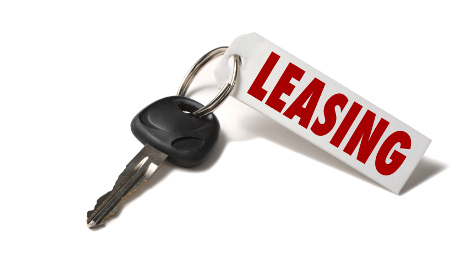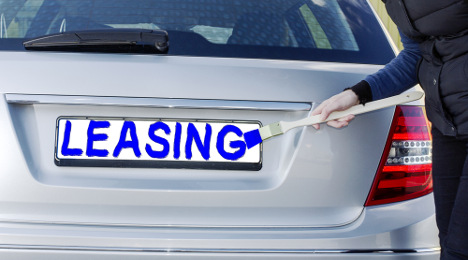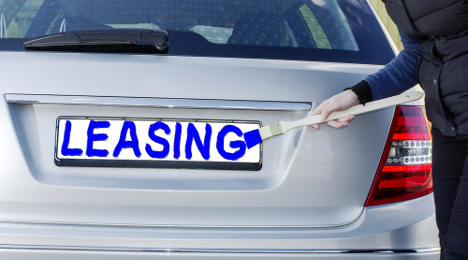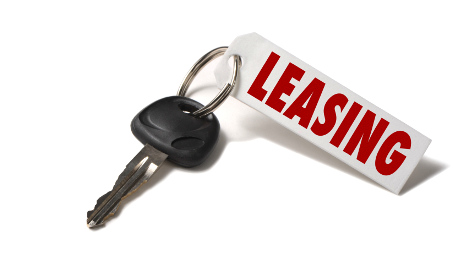An environment where leases account for 30 percent of new-vehicle sales (give or take) may be the new normal.
While there is not likely to be another major increase, lease penetration isn’t likely to “drop off any time soon,” says Eric Lyman, ALG’s chief industry analyst.
The firm spotted 32-percent lease penetration earlier this year, and anticipates numbers from this past month to come around 30 percent, based on seasonality in prior years.
Lease penetration rates have been north of 30 percent in 12 of the last 16 months, according to data shared by Edmunds (should current projections for April hold). As of Monday morning, Edmunds was forecasting April’s lease penetration rate at 30.2 percent, a preliminary figure the company said will be finalized later this week.
“Leasing is clearly here to stay,” Lyman said in an interview last month. “We’ve seen a massive increase in the lease penetration rate. We expect that trend to continue.”
And that is a positive for the car business, he said, provided the back-end process is managed well. Leasing can mean a faster turn rate and a younger vehicle fleet, Lyman said. He also argues that from a safety standpoint, lowering the average age could be beneficial.
“Ultimately, a higher lease penetration increases velocity, which can support higher sales volume over the long term. And as long as we can manage it on the back end,” Lyman said. “The U.S. vehicle fleet or the car park is at a historical all-time high with (cars) almost 12 years old, so if we can get a higher turnover of vehicles on the new-car side and that facilitates bringing that back down to maybe a number that’s more in line with long-term averages, that’s not such a bad thing either.”
OEMs pulling back?
Not everyone shares this assessment. In a quarterly earnings conference call, Sonic Automotive executive Jeff Dyke said he has seen some automakers pull back, pushing for more traditional sales rather than leases.
“And I think it’s because of all the cars coming off lease and the residual values that they’re seeing. So, their finance companies are making the operating companies do things that maybe they don’t want to do right now,” Dyke said. “If anything, I’m not seeing a huge push to lease; I’m seeing the opposite of that.”
As a member of a few dealer boards, Dyke said that there have been discussions around trying to balance a decrease in leasing and a lift in traditional sales, all while maintaining margins and volumes — and trying to remain competitive.
“I think it’s a conundrum right now and it’s something that we’re going to have to work on as we move forward this year,” he said.
As alluded to in an analyst’s question and confirmed by Dyke, one challenge to decreasing leasing is the disparity between lease and finance monthly payments, which can be a struggle to get a consumer to look past.
“There’s a huge gap,” Dyke said. “And you’re not going to be competitive with vehicles that have $100-, $150-, $75-more-a month monthly payment in a straight buy versus a lease. So it’s an issue, an issue we’re going to have to deal with. They’re going to have to meet more in the middle.
“The cost is going to have to come down and the lease residual value is going to have to go up,” so they don’t get hit hard when the term ends, he said.
Dyke added, “But something’s going to have to change, or we’re going to sell a lot less cars.”
But, used-car sales could climb, Dyke confirmed to the analyst, something he said the retailer has long predicted.
Appeal to younger generation
As the concept of auto ownership continues to evolve in the era of Uber and the development of self-driving cars, leasing appears to be striking a chord with millennials.
ALG has observed Generation Y “over-index on leasing,” Lyman said.
“This is a generation that’s more comfortable with the concept of use as you go, or sort of pseudo-ownership of things that they rely on for living life day-to-day” including everything from cell phones to models like Rent the Runway or Blue Apron, he said.
It’s a matter of convenience and experience, and leasing is along similar lines, he said.
Of course, there’s the viewpoint that paying for an asset you don’t own isn’t particularly wise, Lyman said. But then there is the counter-argument.
“I think the current generation views things as, ‘I can use this thing, while it’s under warranty. I can rest assured that if there’s any issues, it’s going to be taken care of. It’s actually less of a burden on my monthly cash flow, and you know, so what if it’s not ‘mine’? It effectively is mine. I can use it when I want, I can do with it what I want within reason that supports my normal life, and then in three years, boom, I can move on,’” he said.
“This is a generation that’s used to the idea of disposable goods, and I think leasing is just a bigger example how they view a lot of the things that they ‘own’ and use,” he said. “Who cares if it’s a $35,000-40,000 asset? I’m paying $250 a month, which is not unreasonable in terms of what I’m getting in terms of value and need a car for, and in three years, I can get a new one.”
Just like when trying to turn used vehicles, Penske Automotive Group chairman Roger Penske also sees an inventory mismatch when dealer group stores look to put their customers into a lease for a new model.
Penske addressed the new-vehicle leasing situation and the potential impact on residual values when the dealer group hosted its quarterly conference call as the company also touted the success of its standalone used-vehicle operations.
“I think right now you’ve got to step back and look at what the marketplace is demanding and it’s demanding SUV and trucks,” Penske said. “I don’t think that the supply base is matched with what’s being sold at the moment.
“So that’ll take some pressure potentially off incentives if the manufacturers can produce enough trucks and SUVs and slow down the sedan,” he continued. “From a residual standpoint, I think there’s no question that that’s been a tool, it’s been in the background that the manufacturers’ finance subsidiaries have been able to do manage through up or down movement of the residuals to affect the realistic payment in the marketplace.”
Penske reiterated that decisions about production, incentives and residual values are all made by the automakers, not dealers. Those choices are all the more important in the luxury segment, according the dealer group boss.
“We have to have a competitive lease rate, and we’re seeing most of our leases in the premium luxury being approximately 30 to 36 months,” Penske said. “There’s no question that that’s a great length of payment because we get that customer back in.”
More on used-car stores
As previously reported by Auto Remarketing, Penske posted a used-vehicle performance lift during the first quarter thanks in part to the addition of U.S.-based CarSense and U.K.-based CarShop, both of which are stand-alone specialty retailers of used vehicles.
During Q1, Penske reported these used-vehicle dealerships retailed 8,200 units. The investment community questioned if Penske wanted to collect more operations like CarSense and CarShop.
“Well, there are a number of smaller used-car businesses around the U.S. We’ve looked at some of these,” he replied. “Some of them are tied to finance companies and other aspects of the used business. I would have to say our mission probably right now both in the U.K. and the U.S. will be greenfield sites to grow.
“The good news is they have a model that’s working,” he continued. “We understand the compensation metrics. We have a parts and service business, which gives us an advantage because of the units in operation. That’s one thing you got to remember that there’s still a parts and service metric on this particular business, and I think that’s one of the benefits buying an existing business.”
So is Penske ready to make more deals in the U.S. or the U.K.?
“I can assure you that I’m sure everyone that’s in the space is going to be looking to see is there anybody out there could be an acquisition, and if there is, I’m sure we’ll be knocking on the door,” Penske said. “But at this point, I don’t have anything that would be meaningful that we would tuck in.”
Imbalance in the mix
Especially here in the U.S., Penske is watching the wholesale market to find the specific vehicles dealer group customers want. And like in the leasing space, SUVs and the like are in demand. Cars? Not so much.
Penske indicated his used-car inventory stands about 39 days.
“We need more vehicles,” he continued. “We certainly see that as we look at our used-car superstores from the standpoint of having enough inventory to continue to grow. I think we got to learn how to be able to buy right at these auctions and look at the OEM auctions to get vehicles.”
“The supply of the right vehicles might be a little bit tough because the mix has changed,” Penske went on to say. “People today want trucks and SUVs. There seems to be an oversupply of used sedans coming through. So, we’re going to balance that out in inventory over the next several months.”
Digital presence
Like many of his dealer group contemporaries, Penske also was asked about online retailing, especially as Carvana gains more steam with additional sales and its initial public offering.
Penske highlighted online volume to company stores is up about 12 percent year-over-year with the dealer group updating websites with “responsive designs.” He added that 50 percent of the group’s site traffic comes through mobile devices.
“So we have to be on top of that,” he said.
Penske also noted the dealer group has the online capability to help customers through what he called “preferred purchase.” The process can help potential buyers evaluate their trade-in value, gather information about financing and more before they arrive at the dealerships.
And if the customer doesn’t want to go to the store to complete deliver?
“We certainly feel from an overall standpoint, the ability for us to deliver a car to a home or to do it to an office is certainly something that’s viable, and we do that already,” Penske said.
Swapalease.com reported on Wednesday that the approval rate for vehicle lease transfers improved in March both on a year-over-year and month-over-month basis.
The site indicated credit applicants registered a 75.0 percent approval rate for March, up by 3.8 percent versus February, which had a 72.2 percent approval rate. A year ago, the approvals rate came 66.7 percent.
Despite rising incentives and an increase in the number of lease returns to dealerships, Swapalease.com pointed out dealers continue to push lease deals for consumers. The most recent lease outlook from RVI Group said the firm expects lease penetration to remain near all-time-high levels.
Meanwhile, Swapalease also mentioned 2017 is already showing higher lease credit approval rates than 2016. Data from the past three years shows that the beginning of the year tends to have a slightly lower approval rate, but so far 2017 has not followed suit, with two straight months above 70 percent on approvals.
“After 2016, which saw an increase in the number of overall applicants, as well as a higher number of non-approvals, it’s good to see 2017 begin to see higher approval rates," said Scot Hall, executive vice president of Swapalease.com.
“We’ll have to see how the next few months come together, but we’re cautiously optimistic that we’ll see this rate of higher approvals continue,” Hall added.
The latest RVI Risk Outlook from RVI Group not only recapped February wholesale prices movements, but firm analysts projected where new-model lease penetration will trend through 2020 and how much of a pricing impact that level could make.
In the first-quarter report released on Tuesday, RVI Group indicated real used-vehicle prices (seasonally adjusted for 2- through 5-year-old units) continue to decline on a year-over-year basis. Analysts found that real used-vehicle prices (after adjusting for MSRP) fell by 6.4 percent in February when compared to the same month last year.
When compared to the previous month, RVI Group noticed real used-vehicle prices declined by 2.5 percent
In the small SUV segment, analysts pointed out prices fell by 5.9 percent on a year-over-year basis, performing better than the market average.
“The increasing supply of used vehicles and steady growth of incentive activity will continue to put downward pressure on used-car prices,” RVI Group said in the report that can be downloaded here.
RVI Group then projected that lease penetration will remain near “historical highs” through 2020.
“As the off-leased vehicles re-enter the market, we expect to see further declines in used-car prices,” analysts said. “Real used-vehicle prices are expected to decline 12.5 percent from current levels by 2020.”
Also in the report, RVI Group recapped that new-vehicle sales declined slightly in February to 17.5 million SAAR from 17.6 million in January. On a year-over-year basis, the report indicated vehicle sales declined by 0.8 percent in February.
Analysts mentioned the lease penetration rate for the fourth quarter of 2016 came in at 22.7 percent of total sales, a decline from 22.8 percent in the third quarter of the same year.
RVI Group went on to note that market level incentive activity has continued to grow, increasing to 10.0 percent of MSRP in February from 9.6 percent of MSRP in January. In February, analysts also highlighted the new vehicle CPI increased by 0.5 percent on a year-over-year basis but decreased by 0.2 percent on a month-over-month basis.
In recapping other trends collected by federal agencies, RVI Group highlighted that key economic indicators showed signs that the U.S. economy is steady.
In the fourth quarter of 2016, analysts said GDP grew at an annual rate of 1.9 percent, down from 3.5 percent growth in the third quarter.
“The slowdown was due to negative contributions from exports and federal government spending that offset positive contributions coming from personal consumption expenditure, private inventory investment, residential and nonresidential fixed investment, and state and local government investment,” RVI Group said.
In February, analysts recapped that the U.S. unemployment rate came in at 4.7 percent, a decline from 4.8 percent from the previous month, while the labor participation rate showed little change from January to February. Meanwhile, inflation came in at 2.7 percent, the highest inflation rate since March 2012, according to RVI Group’s report.
With leasing activity continuing to evolve as analysts recently conveyed to Auto Remarketing, Growella — a financial education website for millennials — researched and published its list of the cheapest 100 vehicles to lease to put what it called “real, actionable information in the hands of today's car shoppers.”
Using vehicle depreciation data, average insurance costs and gas efficiency ratings, Growella ranked 100 models with an MSRP of $30,000 or less from most affordable to least affordable. Growella’s research uncovered that the most affordable vehicle to lease is the Mitsubishi Mirage, at $219 per month. The next most affordable vehicle to lease is the Subaru Outback at $234 per month, followed by the Nissan Versa at $307 per month.
Here are the top 10 according to Growella’s findings:
1. Mitsubishi Mirage
2. Subaru Outback
3. Nissan Versa
4. Subaru Impreza
5. Jeep Cherokee
6. Kia Soul
7. Hyundai Accent
8. Kia Rio
9. Toyota Corolla
10. Mazda MAZDA3
“A leased car costs more than just its monthly payment,” Growella founder Dan Green said. "When a driver leases a car, the costs of auto insurance and gasoline have to be considered, too.”
To determine the cost of leasing a vehicle, Growella assumed:
—A 25-year-old female driver in a city setting with no traffic offenses
—A 36-month lease
—Depreciation equal to the value of a trade-in car in 2017 minus its MSRP of three years ago at 15,000 miles driven per year
—Gas mileage as provided by manufacturers
—An average gas price as provided by FuelEconomy.gov
Growella also assumed the driver did not shop for new auto insurance during the lease, and that she neither moved, nor incurred a traffic offense, nor changed her driving habits.
To read the complete list of the 100 cheapest vehicles to lease, go to this website.
As Swapalease.com noticed the approval rate for vehicle lease credit applicants jumped more than 30 percent in February, Experian and Edmunds also offered data and analysis on the leasing market — the former looking back at fourth-quarter metrics and the latter reviewing last month’s performance and projecting ahead for the remainder of the year.
Edmunds executive director of industry analysis Jessica Caldwell explained that leasing “continues to drive new-car sales, but at a slower rate.” Caldwell indicated the February lease penetration rate softened 11 percent year-over-year, “and we expect lease penetration to decline overall in 2017 to 30 percent (compared to a record 32 percent in 2016).”
Meanwhile, according to Experian’s latest State of the Automotive Finance Market report, the number of consumers who chose to lease a new vehicle increased slightly from 28.87 percent in Q4 2015 to 28.94 percent in Q4 2016. For consumers who still want to drive something new, Experian computed that leasing a new vehicle costs an average of $92 less per month compared with retail financing.
The average monthly payment for a new leased vehicle is $414, versus $506 per month for a new-vehicle purchase.
Experian also shared some additional information exclusively with Auto Remarketing. The table below shows the top 20 new models leased in Q4 and their market share.
| |
Model |
Share Of
New Lease Market |
| 1. |
Honda Civic |
2.98% |
| 2. |
Honda CR-V |
2.85% |
| 3. |
Nissan Rogue |
2.77% |
| 4. |
Ford Escape |
2.51% |
| 5. |
Toyota RAV4 |
2.48% |
| 6. |
Honda Accord |
2.46% |
| 7. |
Chevrolet Equinox |
2.44% |
| 8. |
Toyota Corolla |
1.89% |
| 9. |
Jeep Grand Cherokee |
1.69% |
| 10. |
Toyota Camry |
1.59% |
| 11. |
Ford F-150 |
1.49% |
| 12. |
Ram 1500 |
1.48% |
| 13. |
Toyota Highlander |
1.47% |
| 14. |
Ford Fusion |
1.46% |
| 15. |
Hyundai Elantra |
1.42% |
| 16. |
Chevrolet Silverado 1500 |
1.40% |
| 17. |
Volkswagen Jetta |
1.39% |
| 18. |
Nissan Altima |
1.27% |
| 19. |
Ford Explorer |
1.26% |
| 20. |
BMW 3-Series |
1.06% |
Also helping to move that new metal are incentives. But perhaps, at least for now, that incentive activity isn’t overheating.
ALG estimated the average transaction price (ATP) for a new light vehicle was $33,307 in February, up 1.9 percent from a year ago. ATPs in February declined by 0.7 percent compared to the prior month while showing a gain of 1.9 percent over the prior year.
ALG added that average incentive spending per unit grew by $409 to $3,443.
“A sizeable gain in average transaction prices is offsetting higher incentive spending, landing the ratio of incentives to ATP at 10.3 percent,” ALG chief analyst Eric Lyman said. “From ALG’s viewpoint, incentive spending as a percentage of ATP of 10 percent or lower represents a healthy retail sales environment for the industry.”
“It’s positive to see incentives relative to ATP pull back from the higher levels in Q4 of 2016. We also expect lower inventories combined with an uptick in demand during the spring selling season to bring further relief in this key metric of industry health,” Lyman continued.
Brad Korner, general manager for AIS Rebates, offered a slightly different perspective. AIS Rebates, a Cox Automotive company, is a firm specializing in rebate and incentive research, publication and analysis.
“Incentives remain high with numerous programs and significant dollars in play to help sustain sales,” Korner said. “Incentives are being used as strategic advertising by the automakers and dealers to drive showroom traffic and excite in-market buyers.
“Smart incentives may be more effective marketing tools than high-dollar ad campaigns, like those that run during the Oscars or the Super Bowl,” he added.
For whatever reason a customer might now want to exit a lease, Swapalease.com reported encouraging trends for that slice of the market. Site officials said applications registered a 72.2 percent approval rate for February, up by 33.3 percent from January, which had just a 50.0 percent approval rate.
The approvals rate was also 72.2 percent in February of last year.
After January’s record low approval rate of 50.0 percent, Swapalease.com noted that February has shown a significant improvement in the number of lease credit approvals. The last time lease credit approval rates registered this high was October 2015, when the lease credit approval rate was 75.0 percent
“We’ve had a string of down months lately, but with the volatility in lease credit approvals currently, it was expected that we would see a bounce back in higher approvals,” said Scot Hall, executive vice president of Swapalease.com. “We do not believe there is anything special about February lease applicants, but it is interesting to know February also saw a high approval rate a year ago.”
This week, White Clarke Group released its 20th annual Global Leasing Report, what the company contends is the only guide to the top 50 leasing markets in the world, summarizes leasing volumes and other market trends.
Officials highlighted the report reveals an optimistic industry outlook with positive growth and continued confidence.
White Clarke Group calculated overall global volumes reached the $1 trillion milestone as leasing “finally shrugged off the effects of the great recession, with growth in the industry outperforming that of the overall economy.”
The report showed North America remained top of the world’s largest leasing regions, increasing its lead on Europe, and the United States remained the world’s largest leasing market by double-digit growth.
Analysts said Europe performed well as its two largest and most mature leasing countries, U.K. and Germany, continued to improve, with the U.K. achieving a 14-percent increase. The rise within both of these markets was driven in part by auto finance.
White Clarke Group went on to mention Asia showed the fastest growth of any region as China continued its rapid rise towards top place, expanding its leasing market more than 25 percent in one year. Business volumes were driven by infrastructure, manufacturing and a resilient car market.
White Clarke Group chief executive officer Brendan Gleeson said, “2016 brought some significant economic and political events, namely Brexit and the election of Donald Trump as U.S. president. Both events have brought short-term volatility on the global foreign exchange and stock markets.
“It is too early to assess how these events impact upon the economies of the world and the global leasing industry in the medium term, but there may be some resulting economic instability in 2017,” Gleeson added.
The report can be downloaded here. Analysts also discussed the report in a video available here and at the topic of this page.
The International Automotive Remarketers Alliance announced on Tuesday it has updated its new website by integrating association management software designed to improve online membership management.
The software was created to manage alliance membership, improve communication within the organization, streamline online education and enhance other website functionalities, according to the alliance.
“The IARA board commissioned IARA executive director Tony Long and members of the alliance’s Technology Committee to seek an AMS solution, which it found in MemberLeap, a product by Vieth Consulting,” the IARA said in a press release.
The software now helps streamline the processes for IARA’s CAR Certification program, a remarketing certification program. Things like student enrollment, course delivery, automated deadline reminders, and proctored online testing are delivered through MemberLeap. It can also be used to monitor course progress and to print certificates and maintain records.
IARA announced it had launched its new website, IARA.biz, earlier this month.
One significant change IARA made with the website is that it now allows members to access all sections of the site with one sign-in password.
Software review company Capterra ranked MemberLeap as the No. 1 top mid-range association management software, according to the IARA.
On IARA's new website, there is also now a registration link for IARA-Northwood University's remarketing course.
George W. Bush was not even two full years into his first term as president the last time off-lease volume hit a true peak.
That was 15 years ago and the auto industry has gone through, shall we say, a bit of change since then.
Off-lease volumes that year were just under 3.5 million units, according to data in Manheim’s 2017 Used Car Market Report. This year, Manheim projects a record 3.6 million vehicles coming off lease, which would also be the fifth straight year volumes have increased.
But the peak won’t even occur until 2020, when 4.6 million off-lease vehicles hit the market, Cox Automotive Inventory Solutions president Janet Barnard said during a press conference here at the NADA Convention & Expo.
This time around, it also appears that the industry better equipped to handle such volume floods.
“I would say, first off, that they’re definitely handling it better,” Cox Automotive chief economist Tom Webb said of consignors, who would typically be the ones selling these vehicles in wholesale channels. “There’s obviously been a big structural shift in the industry.
“The last peak in off-lease volumes was way back in 2002. And that’s when you actually had a significant amount of leasing being done by banks, who really didn’t have the inherent interest in protecting residual values, didn’t have all the levers and strings that a captive lessor can control,” said Webb, who spoke with Auto Remarking by phone shortly after the convention.
Not only is the remarketing environment different this time around, consignors are keenly aware of the volumes expected, Webb said. And they’re aware that certified pre-owned programs, where many off-lease units end up, compete to a degree with new-car sales.
And, Webb added, consignors, “to a certain extent, have reserved moneys, knowing that there might be some end-of-term losses … proactive policies like that.
“And certainly in terms of remarketing, we’ve always been in the situation where the consignor has a greater knowledge of the market and where to put these vehicles,” he said. “Because your off-lease volumes may be coming back in a region of the country where the demand is really not there and is probably stronger somewhere else; so, you always have that option of whether to ship the cars to the buyers or bring the buyers to the car, in terms of eyeballs, through simulcast, etc.”
They’re apt to experiment when different methods of handling volume gains, Webb said. And consignors are also using analytics to arrive at those distribution decisions, says Anil Goyal, who is Black Book’s senior vice president of automotive valuation and analytics.
“There’s a lot of analytics going on around that as to when do we want to push that product into the auction lanes,” Goyal said in an interview at NADA. “It used to be that, three or four years ago, when volume came back, (they said) let’s just push it to the auction next week.
“I think they’re being more savvy around, hey, let’s distribute the volume from a timing perspective,” he said. “Let’s distribute the volume from a (regional) perspective, where that vehicle needs to be shipped. Especially on off-lease, it tends to be focused more on certain regions like the Northeast and California.”
Other strategies being implemented include direct-to-dealer sales and programs that that incentivize franchised dealers to purchase off-lease units, Goyal said.
GM Financial, for instance, utilizes both of those methods. Nick Heinz, who is the company’s vice president of remarketing solutions, said in an interview here that GM Financial hopes to further engage its dealers with its online platform, GMFDealerSource.com
When asked if GM Financial has any sort of collaborative work with the General Motors CPO program, Heinz pointed to the captive’s dealer-facing incentive program called GM Financial Dealer Dividends.
Dealers might earn dividends for originations engagement and buying grounded lease vehicles, Heinz said, which then go into their dividends bank.
Dealers can put those dividends towards a variety of different things on the new- and used-car side, he said, including reimbursement on certified pre-owned fees, for example.
Point is, there are many ways to handle this challenge.
“It’s a matter of just being very cognizant about when that product comes back, let’s not just push it all in one channel,” Goyal said, “and (instead) distribute it across channels and across markets.”
And automakers and their lending arms/partners certainly have to find a balance between the amount of leases they write and the potential impact to residual values, says Jessica Caldwell, who is executive director of industry analysis at Edmunds.
So to strike that balance, automakers are turning to tactics like mileage restrictions, longer leases and adjusting the timing on lease returns, she said.
In other words, not pulling back massively on the amount of leases, but rather maneuvering around the amount hitting the market.
“All of that,” Caldwell said in an interview here, “trying to just optimize all the vehicles coming back off of lease returns.”
When it comes to lease search activity in the fourth quarter, Hyundai and Subaru showed the most growth, according to Swapalease.com, with GMC highlighting activity for the domestics.
Searches for Hyundai on the car lease marketplace website were up 25 percent from the third quarter, while Subaru’s traffic was up 15 percent.
GMC, with a 6-percent hike in search activity, was the lone domestic brand to show an increase.
Meanwhile, Mercedes-Benz (up 3 percent) and Audi (up 2 percent) were the two European brands showing an increase.
Overall, Swapalease said in its quarterly lease trends report: “The additional brands that saw declines suffered from a seasonal pinch as many consumers were also focused on holiday spending, in addition to vehicle shopping.”
Compared to Q4 2015, Subaru topped the list (up 21 percent), with Hyundai in second (up 17 percent).
GMC (up 15 percent) was third, with Chevrolet and Audi both up 11 percent. Mercedes-Benz showed no change, but the remainder of the brands were down.
As for the share of overall market activity on the site, BMW remains in first at 12 percent, despite dipping from 15 percent in the prior quarter. Next up is Mercedes-Benz (11 percent), followed by Lexus (10 percent).
Ford leads the domestics at 9 percent.
Small cars accounted for 8.2 percent of cars being leased (up from 5.9 percent in Q3), midsize cars accounted for 16.8 percent (up from 14.9 percent). Meanwhile,12.2 percent were leasing full-size cars, down from 12.6 percent in Q3.
Sports cars accounted for 5.3 percent of leases, same as Q3.
SUV share dipped from 16.6 percent to 13.9 percent, while crossover share increased from 2.7 percent to 4.2 percent. Truck share fell from 4.4 percent to 2.0 percent.
Average monthly payments were at $435.35, compared to $445.85 in the prior quarter.
In an interview for a separate story, Swapalease executive vice president Scot Hall discussed payment a bit.
“A quick rule of thumb is every $1,000 that’s put down toward a 36-month lease changes that payment about $30,” he said. “I think it’s a best leasing practice and would be Swapalease’s recommendation to put down as little money down on a lease as possible.
“Granted that means you’ll have a higher monthly payment if a down payment is being requested. But I think most people from a budgeting standpoint — whether they have that cash in their back pocket or not — would be better off keeping $1,000 in the bank longer and adjusting to an additional $30 a month in terms of a monthly budget,” Hall said. “I just think it’s a better safety net for consumers to have.”
Staff Writer Nick Zulovich contributed to this story.












